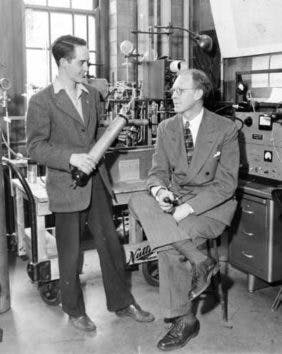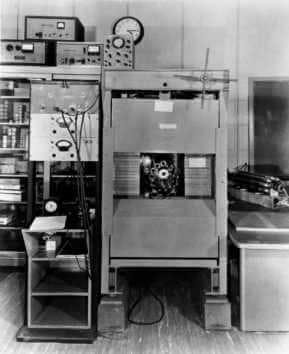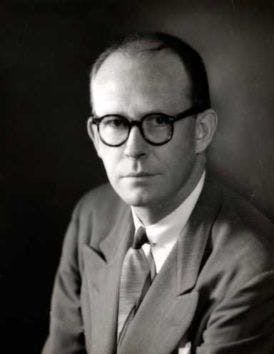On Oct. 10, the American Chemical Society will dedicate a National Historic Chemical Landmark at the University of Chicago in Chicago, Illinois, in honor of Willard Libby’s discovery of radiocarbon dating. Libby’s method for dating organic materials by measuring their content of carbon-14 provides objective age estimates for carbon-based objects that originated from living organisms. […]


On Oct. 10, the American Chemical Society will dedicate a National Historic Chemical Landmark at the University of Chicago in Chicago, Illinois, in honor of Willard Libby’s discovery of radiocarbon dating. Libby’s method for dating organic materials by measuring their content of carbon-14 provides objective age estimates for carbon-based objects that originated from living organisms. Libby’s discovery greatly benefitted the fields of archaeology and geology by allowing practitioners to develop more precise historical chronologies across geography and cultures.
Libby was inspired Serge Korff’s 1939 discovery that the bombardment of the atmosphere by cosmic rays produced neutrinos. Korff predicted that the reaction between these neutrons and nitrogen-14, which predominates in the atmosphere, would produce carbon-14, also called radiocarbon. Libby realized carbon-14 in the atmosphere would find its way into living matter. Theoretically, if one could detect the amount of carbon-14 in an object, one could establish that object’s age using the half-life, or rate of decay, of the isotope. In 1946, Libby proposed this groundbreaking idea in the journal Physical Review.
Making Predictions About Carbon-14

The concept of radiocarbon dating focused on measuring the carbon content of discreet organic objects, but in order to prove the idea Libby would have to understand the earth’s carbon system. Radiocarbon dating would be most successful if two important factors were true: that the concentration of carbon-14 in the atmosphere had been constant for thousands of years, and that carbon-14 moved readily through the atmosphere, biosphere, oceans and other reservoirs—in a process known as the carbon cycle.
In the absence of any historical data concerning the intensity of cosmic radiation, Libby simply assumed that it had been constant. He reasoned that a state of equilibrium must exist wherein the rate of carbon-14 production was equal to its rate of decay, dating back millennia. (Fortunately for him, this was later proven to be generally true.)
For the second factor, it would be necessary to estimate the overall amount carbon-14 and compare this against all other isotopes of carbon. Based on Korff’s estimation that just two neutrons were produced per second per square centimeter of earth’s surface, each forming a carbon-14 atom, Libby calculated a ratio of just one carbon-14 atom per every 1012 carbon atoms on earth.
Detecting Radiocarbon in Nature
Carbon-14 was first discovered in 1940 by Martin Kamen and Samuel Ruben, who created it artificially using a cyclotron accelerator at the University of California Radiation Laboratory in Berkeley. Further research by Libby and others established its half-life as 5,568 years (later revised to 5,730 ± 40 years), providing another essential factor in Libby’s concept. But no one had yet detected carbon-14 in nature— at this point, Korff and Libby’s predictions about radiocarbon were entirely theoretical. In order to prove his concept of radiocarbon dating, Libby needed to confirm the existence of natural carbon-14, a major challenge given the tools then available.
At the time, no radiation-detecting instrument (such as a Geiger counter) was sensitive enough to detect the small amount of carbon-14 that Libby’s experiments required. Libby reached out to Aristid von Grosse of the Houdry Process Corporation who was able to provide a methane sample that had been enriched in carbon-14 and which could be detected by existing tools. Using this sample and an ordinary Geiger counter, Libby and Anderson established the existence of naturally occurring carbon-14, matching the concentration predicted by Korff.
This method worked, but it was slow and costly. Fortunately, Libby’s group developed an alternative. They surrounded the sample chamber with a system of Geiger counters that were calibrated to detect and eliminate the background radiation that exists throughout the environment. The assembly was called an “anti-coincidence counter.” When it was combined with a thick shield that further reduced background radiation and a novel method for reducing samples to pure carbon for testing, the system proved to be suitably sensitive. Finally, Libby had a method to put his concept into practice.
Testing Radiocarbon Dating

The concept of radiocarbon dating relied on the ready assumption that once an organism died it would be cut off from the carbon cycle, thus creating a time capsule with a steadily diminishing carbon-14 count. Living organisms from today would have the same amount of carbon-14 as the atmosphere, whereas extremely ancient sources that were once alive, such as coal beds or petroleum, would have none left. For organic objects of intermediate ages—between a few centuries and several millennia—an age could be estimated by measuring the amount of carbon-14 present in the sample and comparing this against the known half-life of carbon-14.
To test the technique, Libby’s group applied the anti-coincidence counter to samples whose ages were already known. Among the first objects tested were samples of redwood and fir trees, the age of which were known by counting their annual growth rings. They also sampled artifacts from museums such as a piece of timber from Egyptian pharaoh Senusret III’s funerary boat, an object whose age was known by the record of its owner’s death.
In 1949, Libby and Arnold published their findings in the journal Science, introducing the “Curve of Knowns.” This graph compared the known age of artifacts with the estimated age as determined by the radiocarbon dating method. It showed all of Libby’s results lying within a narrow statistical range of the known ages, thus proving the success of radiocarbon dating.
Radiocarbon dating provided the first objective dating method—the ability to attach approximate numerical dates to organic remains. This method helped to disprove several previously held beliefs, including the notion that civilization originated in Europe and diffused throughout the world. By dating man-made artifacts from Europe, the Americas, Asia, Africa and Oceania, archaeologists established that civilizations developed in many independent sites across the world. As they spent less time trying to determine artifact ages, archaeologists were able to ask more searching questions about the evolution of human behavior in prehistoric times.
When Libby first presented radiocarbon dating to the public, he estimated the method could measure ages of up to 20,000 years. Subsequent advances in carbon-14 detection technology means the method can now reliably date materials as old as 50,000 years.
Acknowledgments
Adapted for the internet from “Discovery of Radiocarbon Dating,” produced by the American Chemical Society’s National Historic Chemical Landmarks program in 2016.